- Cultivation and Care
- Planting
- Watering and Mulching
- Fertilizing
- Support and Staking
- Deadheading and Pruning
- Overwintering
- Pests and Diseases
- Propagation
- Cultivars and Varieties
- Types of Acidanthera
- 1. Acidanthera bicolor
- 2. Acidanthera murielae
- 3. Acidanthera corms
- 4. Acidanthera pearsonii
- 5. Acidanthera aequatorialis
- Acidanthera Varieties
- 1. Acidanthera murielae
- 2. Acidanthera bicolor
- 3. Acidanthera cornutum
- 4. Acidanthera robusta
- 5. Acidanthera corms mix
- Acidanthera: Growing Conditions
- Soil
- Sunlight
- Temperature
- Watering
- Fertilizer
- Mulching
- Support
- Acidanthera: Planting Guide
- Choosing the Right Location
- Preparing the Soil
- Planting Acidanthera Bulbs
- Watering and Mulching
- Fertilizing
- Support and Staking
- Deadheading and Pruning
- Pest and Disease Control
- Winter Care
- Conclusion
- Acidanthera: Maintenance and Pruning
- 1. Watering
- 2. Fertilizing
- 3. Mulching
- 4. Deadheading
- 5. Pruning
- 6. Dividing
- 7. Protection from Cold
- Acidanthera: Common Problems and Solutions
- Pest Infestation
- Disease
- Poor Flowering
- Poor Growth
- Winter Protection
- Questions and Answers:
- How do I cultivate and care for Acidanthera?
- What types of Acidanthera are there?
- When should Acidanthera bulbs be planted?
- Do Acidanthera plants require a lot of water?
- How often should Acidanthera plants be fertilized?
- Should I deadhead Acidanthera flowers?
- Can Acidanthera bulbs be left in the ground over winter?
- Videos: July Garden Tour // Lilies, Gladiolus, Acidanthera, and More!!! // Northlawn Flower Farm
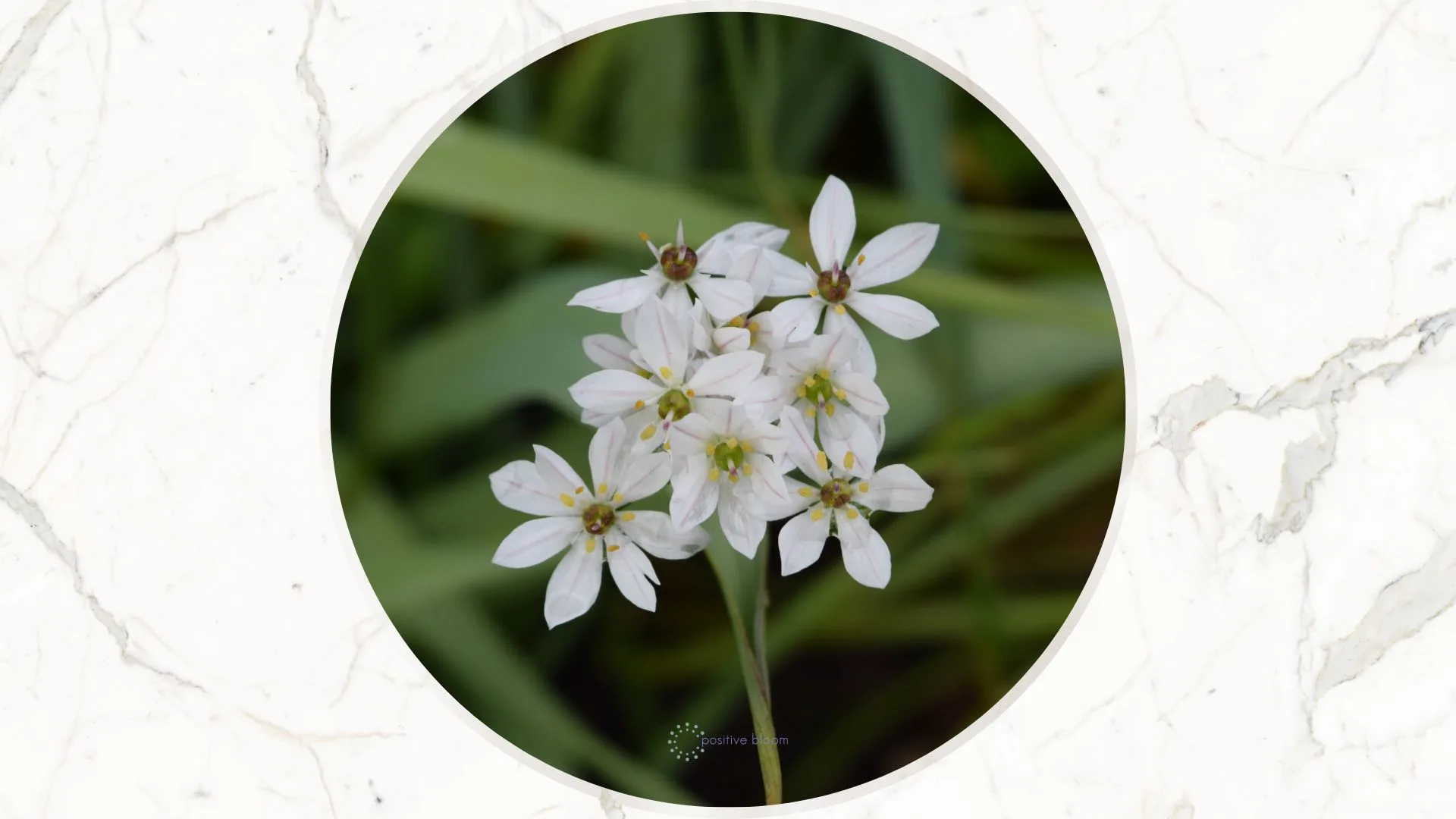
Acidanthera, commonly known as Abyssinian gladiolus or peacock orchid, is a stunning flowering plant that belongs to the iris family. Native to South Africa, Acidanthera is prized for its elegant white flowers with a purple blotch in the center and a sweet, intoxicating fragrance. It is a popular choice for gardeners looking to add a touch of elegance and beauty to their gardens.
Cultivating Acidanthera is relatively easy, making it a great choice for both beginner and experienced gardeners. The plant prefers well-draining, fertile soil and full sun to partial shade. It can be grown from corms, which are planted in early spring or fall, depending on your climate. Once planted, Acidanthera requires regular watering, especially during dry spells, but be careful not to overwater as it can lead to rotting of the corms.
Acidanthera comes in a variety of types and varieties, each with its own unique color and form. The most common type is Acidanthera bicolor, which features white flowers with a deep purple center. Another popular variety is Acidanthera murielae, also known as the Abyssinian sword lily, which produces larger flowers and has a yellow throat. There are also dwarf varieties available, such as Acidanthera murrowsii, which are perfect for container gardening or small spaces.
When it comes to care, Acidanthera requires regular deadheading to promote continuous blooming. It is also recommended to mulch around the plants to conserve moisture and suppress weeds. In colder climates, the corms should be lifted and stored indoors during the winter months to protect them from frost. With proper care and attention, Acidanthera can provide a stunning display of flowers that will enhance any garden or flower arrangement.
Cultivation and Care
Acidanthera, also known as Abyssinian gladiolus or peacock orchid, is a beautiful flowering plant that is native to tropical and subtropical regions of Africa. It is popular among gardeners for its elegant white flowers with purple markings and its delightful fragrance. Here are some tips on how to cultivate and care for Acidanthera:
Planting
Acidanthera bulbs should be planted in the spring, after the danger of frost has passed. Choose a sunny location with well-drained soil. The bulbs should be planted about 3-4 inches deep and spaced 6-8 inches apart. Make sure to water the bulbs thoroughly after planting.
Watering and Mulching
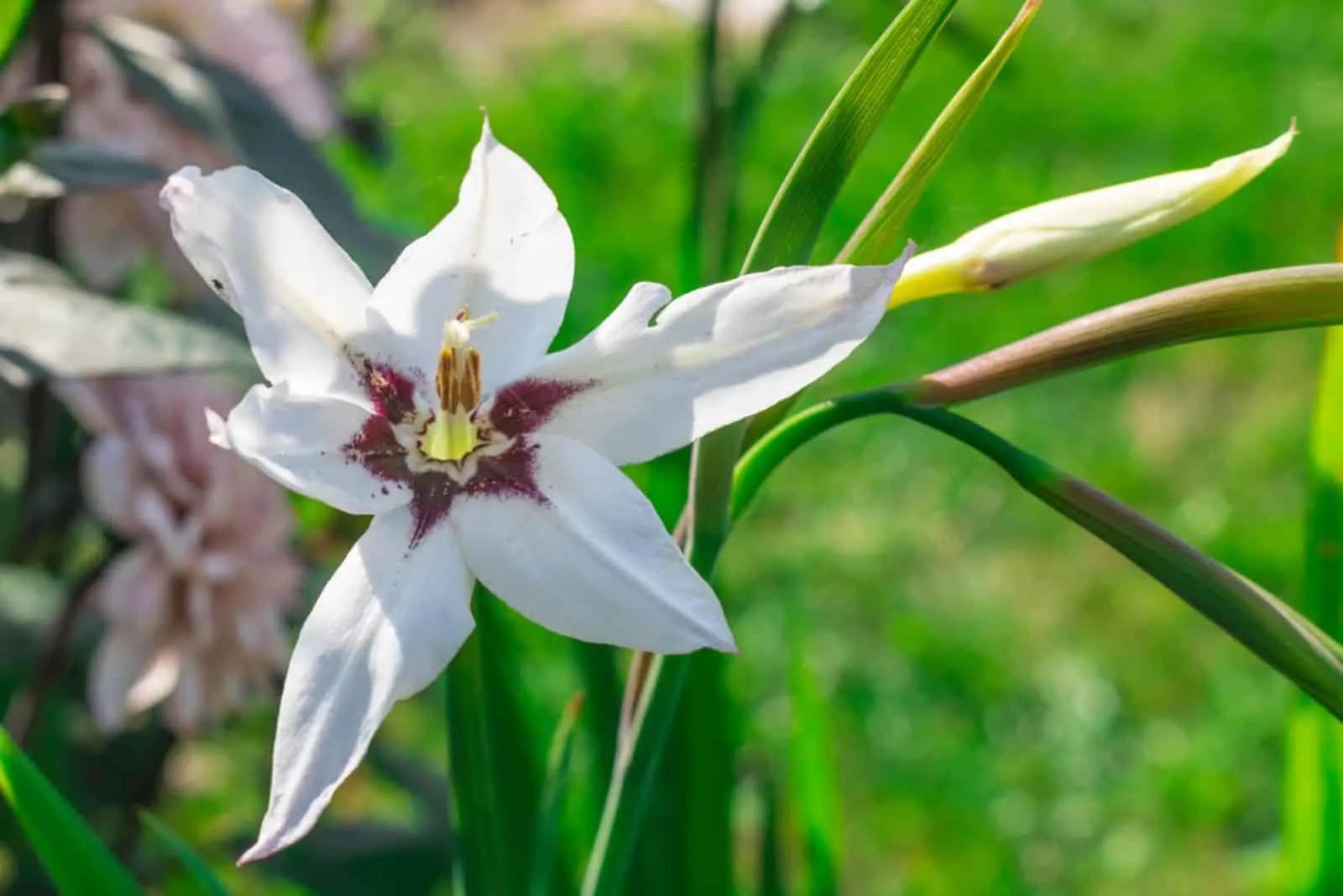

Acidanthera plants prefer moist but not overly wet soil. Water the plants regularly, especially during dry periods. Adding a layer of mulch around the plants can help conserve moisture and regulate soil temperature.
Fertilizing
It is recommended to fertilize Acidanthera plants regularly during the growing season. Use a balanced fertilizer with equal amounts of nitrogen, phosphorus, and potassium. Apply the fertilizer according to the package instructions, usually every 4-6 weeks.
Support and Staking
Acidanthera plants can grow quite tall and may require support to prevent them from falling over. Use stakes or a trellis to provide support for the plants as they grow. Be careful not to damage the bulbs when placing the stakes.
Deadheading and Pruning
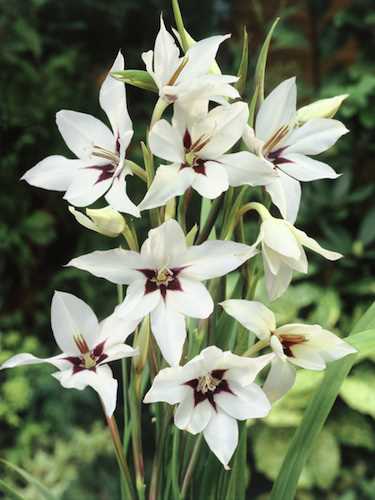

After the Acidanthera flowers have bloomed and wilted, it is important to remove the spent flowers. This process, known as deadheading, helps promote new flower growth. Additionally, you can trim back the foliage after it turns yellow and dies back in the fall.
Overwintering
In colder climates, Acidanthera bulbs are not frost hardy and should be lifted and stored indoors during the winter. After the foliage has died back, carefully dig up the bulbs and remove any excess soil. Store the bulbs in a cool, dry place until spring, when they can be replanted outdoors.
Pests and Diseases
Acidanthera plants are generally resistant to most pests and diseases. However, they can be susceptible to bulb rot if the soil is too wet. To avoid this, make sure the soil has good drainage and do not overwater the plants.
Propagation
Acidanthera can be propagated by dividing the bulbs in the fall. Carefully dig up the bulbs and separate them into individual sections, making sure each section has a healthy bud. Replant the bulbs immediately or store them for winter storage.
Cultivars and Varieties
There are several cultivars and varieties of Acidanthera available, offering a range of flower colors and sizes. Some popular varieties include ‘Murielae’, ‘Bicolor’, and ‘Peacock Orchid’. Choose the ones that best suit your garden design and personal preference.
Types of Acidanthera
There are several types of Acidanthera, each with its own unique characteristics and appearance. Here are some of the most popular types:
1. Acidanthera bicolor
This is the most common and widely cultivated variety of Acidanthera. It features white flowers with purple markings on the throat and a yellow center. Bicolor is a particularly tall variety, often reaching heights of up to 3 feet.
2. Acidanthera murielae
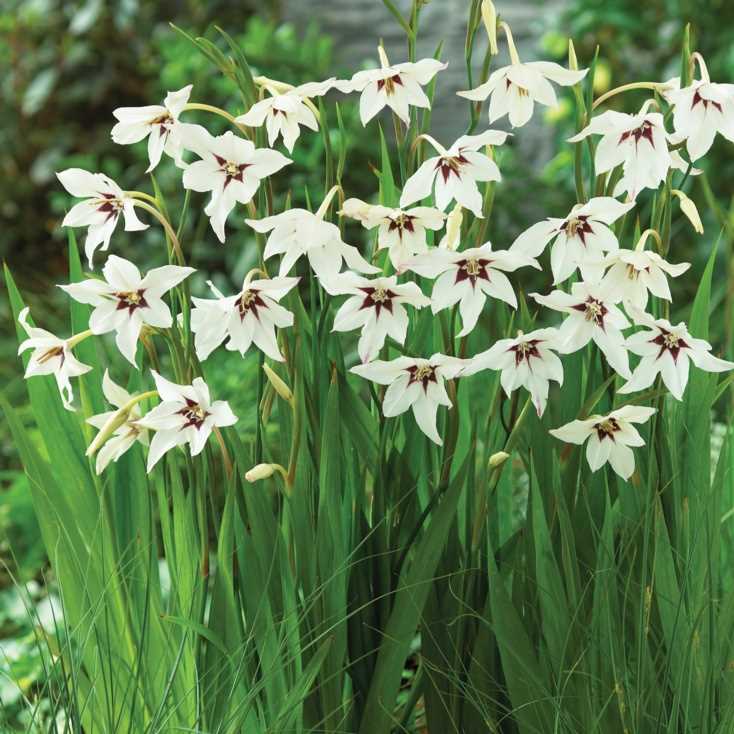

Also known as the Abyssinian Gladiolus, this variety is characterized by its pure white flowers with a deep purplish-black blotch in the center. It can grow up to 4 feet in height and adds a touch of elegance to any garden.
3. Acidanthera corms
These are not specific varieties of Acidanthera, but rather different types of corms available for planting. There are small corms, which typically produce smaller plants with fewer flowers, and large corms, which result in more robust plants with more abundant blooms.
4. Acidanthera pearsonii
This variety is known for its fragrant flowers, which have a sweet, fruity scent. The blooms are predominantly white with a pale pink blush and deep purple markings on the throat. Acidanthera pearsonii is a compact variety, perfect for small gardens or containers.
5. Acidanthera aequatorialis
This type of Acidanthera is often referred to as the Peacock Orchid due to its stunning coloration. Its flowers feature white petals with a distinctive dark purple to maroon center, resembling the eyespot on a peacock’s tail feathers. It is a medium-sized variety, reaching heights of around 2 feet.
These are just a few examples of the many different types of Acidanthera available to gardeners. Each variety offers its own unique beauty and charm, making Acidanthera a popular choice for both beginner and experienced gardeners alike.
Acidanthera Varieties
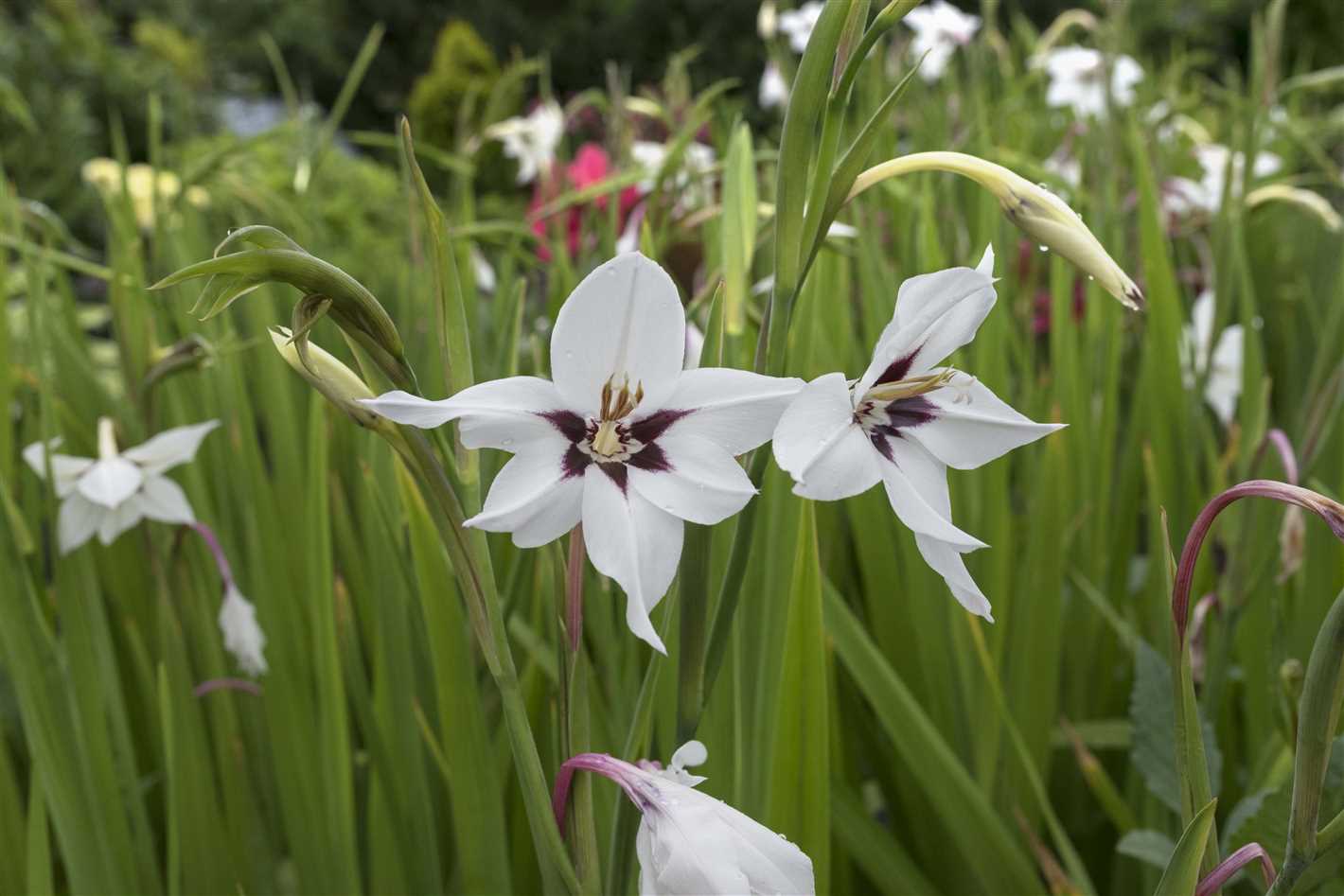

1. Acidanthera murielae
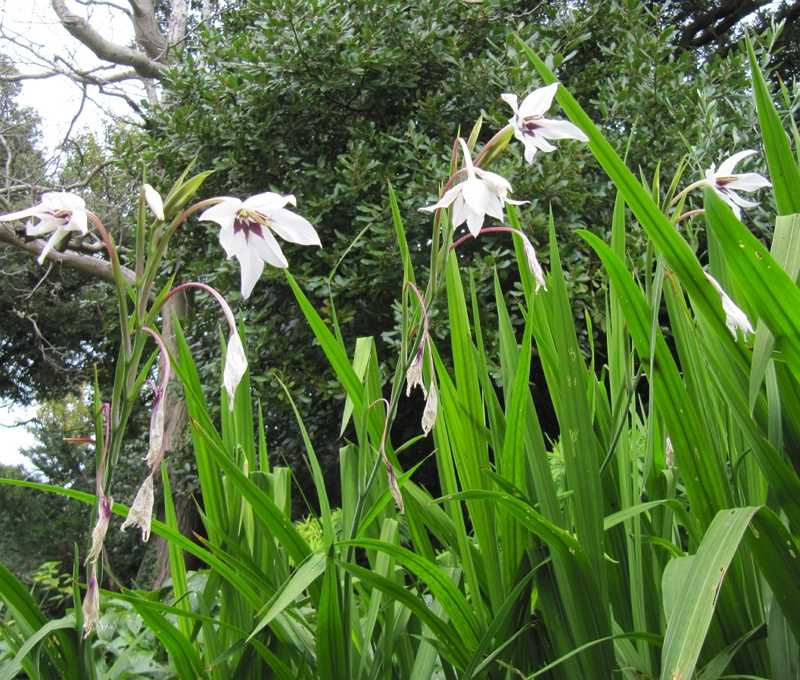

The most common variety of Acidanthera, Acidanthera murielae, is also known as the Abyssinian gladiolus or peacock orchid. It features white flowers with purple markings and a yellow throat. This variety is highly fragrant and has a long blooming period, typically from mid-summer to early fall. Acidanthera murielae is a favorite among gardeners due to its elegant appearance and delightful scent.
2. Acidanthera bicolor
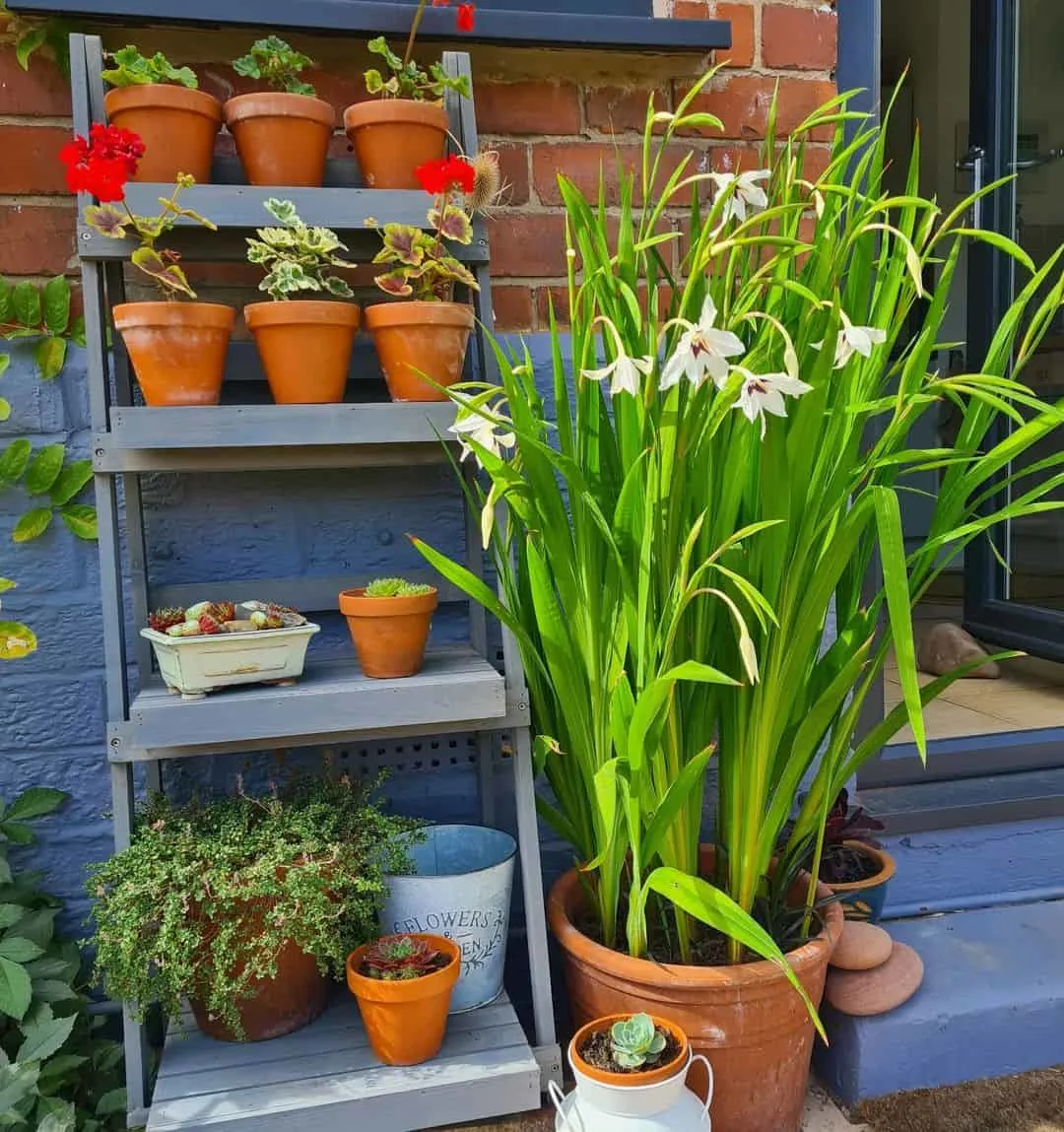

Acidanthera bicolor, also known as the Abyssinian sword lily, is an elegant variety with white and pink flowers. The petals have a distinctive pink stripe in the center, giving the flowers a bicolor appearance. This variety blooms in late summer to early fall and is perfect for adding a touch of color to the garden. Acidanthera bicolor is less common than Acidanthera murielae but is equally beautiful and fragrant.
3. Acidanthera cornutum
Acidanthera cornutum, or the fragrant gladiolus, is a variety with creamy white flowers and a yellow throat. This variety is highly fragrant and perfect for a scented garden. Acidanthera cornutum blooms in late summer and early fall, and its delicate flowers add a touch of elegance to any outdoor space.
4. Acidanthera robusta
Acidanthera robusta is a variety with larger flowers and a deeper purple color. The petals have a velvety texture and a slight ruffle on the edges, giving the flowers a more exotic look. This variety blooms in late summer and early fall and is a great choice for adding a pop of color to the garden. Acidanthera robusta is less common than Acidanthera murielae but is worth seeking out for its striking appearance.
5. Acidanthera corms mix
A mix of Acidanthera corms is also available, offering a variety of colors and flower forms. This mix may include different species and varieties of Acidanthera, creating a wonderful display of colors and shapes in the garden. The Acidanthera corms mix is a great option for those who want to experiment with different varieties and create a diverse and eye-catching flowerbed.
Acidanthera: Growing Conditions
Soil
Acidanthera plants prefer well-draining soil with a pH level of 6.0 to 7.5. Sandy or loamy soil is ideal for these plants as it helps prevent waterlogging. You can improve the soil drainage by adding organic matter such as compost or peat moss.
Sunlight
Acidanthera plants thrive in full sunlight, so choose a location in your garden that receives at least 6-8 hours of direct sunlight each day. If you live in a very hot climate, providing partial shade during the hottest part of the day can help prevent the plants from getting scorched.
Temperature
Acidanthera plants are native to tropical and subtropical regions, so they prefer warm temperatures. The optimal temperature range for these plants is between 70°F (21°C) to 80°F (27°C) during the day and around 60°F (15°C) during the night. Avoid planting them in areas with extreme temperature fluctuations.
Watering
Water the Acidanthera plants regularly during the growing season, especially during dry spells. Keep the soil evenly moist but not waterlogged. Overwatering can lead to root rot, so make sure the water can drain properly. Reduce watering after flowering and allow the foliage to die back naturally.
Fertilizer
Acidanthera plants benefit from regular fertilization during the growing season. Use a balanced fertilizer with an equal ratio of nitrogen, phosphorous, and potassium. Apply the fertilizer every 4-6 weeks according to the package instructions. Be careful not to over-fertilize as it can lead to excessive foliage growth at the expense of flowers.
Mulching
Apply a layer of mulch around the Acidanthera plants to help conserve soil moisture and suppress weed growth. Organic mulch, such as wood chips or straw, works well for these plants. Make sure the mulch is not directly touching the stems to prevent rotting.
Support
Acidanthera plants have tall flowering stalks that can become top-heavy and flop over. Provide support in the form of stakes or a trellis to keep the stems upright. Install the support structures when the plants are still small to avoid damaging the roots later on.
Acidanthera: Planting Guide
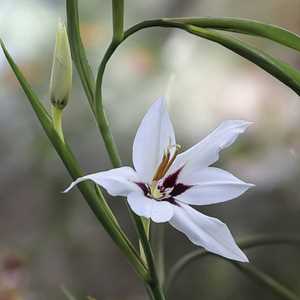

Choosing the Right Location
Acidanthera, also known as Abyssinian gladiolus or peacock orchid, thrives in full sun to partial shade. Choose a planting location that receives at least 6-8 hours of direct sunlight per day for optimal growth and flowering. The soil should be well-draining, rich in organic matter, and slightly acidic.
Preparing the Soil
Before planting acidanthera bulbs, prepare the soil by removing any weeds or debris. Loosen the soil using a garden fork or tiller to a depth of 8-10 inches. Incorporate compost or well-rotted manure into the soil to improve its fertility and drainage.
Planting Acidanthera Bulbs
Plant acidanthera bulbs in the spring, after the danger of frost has passed and the soil has warmed up. Dig a hole that is 4-5 inches deep. Place the bulb in the hole with the pointed end facing up and cover it with soil. Space the bulbs 4-6 inches apart to allow for proper growth and airflow.
Watering and Mulching
After planting, water the bulbs thoroughly to settle the soil and encourage root development. Keep the soil evenly moist but not soggy throughout the growing season. Apply a layer of mulch around the plants to help retain moisture, suppress weeds, and regulate soil temperature.
Fertilizing
Acidanthera bulbs benefit from regular fertilization. Apply a balanced, slow-release fertilizer at planting time and then follow up with additional applications every 4-6 weeks during the growing season. Follow the package instructions for proper dosage and application method.
Support and Staking
As acidanthera plants grow, their tall flower stems may require support to prevent them from flopping over. Install stake or trellis near the plants and gently tie the stems to provide support and keep them upright.
Deadheading and Pruning
Deadhead faded flowers regularly to promote continuous blooming and prevent the plant from putting energy into seed production. Cut back the flower stalks to the base once all the flowers have finished blooming, but leave the foliage intact to provide nutrients to the bulbs for next year’s growth.
Pest and Disease Control
Acidanthera plants are generally pest and disease resistant. However, keep an eye out for common garden pests such as aphids and spider mites. If infestations occur, use organic or chemical insecticides as necessary. Proper sanitation and good cultural practices can help prevent disease issues.
Winter Care
In regions with mild winters, acidanthera bulbs can be left in the ground. Apply a layer of mulch over the bulbs to protect them from freezing temperatures. In colder climates, lift the bulbs in the fall after the foliage has died back and store them in a cool, dry place until the next planting season.
Conclusion
By following these planting and care tips, you can enjoy the beautiful blooms of acidanthera in your garden. With its elegant white flowers and delicate fragrance, this bulbous plant adds a touch of sophistication to any landscape or container garden.
Acidanthera: Maintenance and Pruning
Maintaining and pruning acidanthera plants is crucial for their growth and overall health. Here are some essential maintenance tips for acidanthera:
1. Watering
Acidanthera plants require regular watering, especially during dry periods. Water them deeply but avoid overwatering, as it can lead to root rot. Keep the soil consistently moist but not soggy.
2. Fertilizing
Fertilize acidanthera plants every two to three weeks during the growing season with a balanced, water-soluble fertilizer. This will provide the necessary nutrients for healthy growth and abundant blooms.
3. Mulching
Apply a layer of organic mulch around acidanthera plants to conserve moisture, suppress weeds, and regulate soil temperature. This will also help in preventing soil erosion.
4. Deadheading
Remove faded or spent flowers regularly to encourage continuous blooming. This process, known as deadheading, diverts the plant’s energy from seed production to more flower production.
5. Pruning
Pruning acidanthera plants is necessary to control their size and shape. Cut back the foliage and flower stalks to the ground after they have turned yellow or dried out. This will promote new growth and prevent the plant from becoming overgrown.
6. Dividing
Acidanthera plants tend to multiply quickly and can become crowded. To maintain their vigor and prevent overcrowding, divide the bulbs every two to three years. Dig up the clumps, separate the individual bulbs, and replant them in well-prepared soil.
7. Protection from Cold
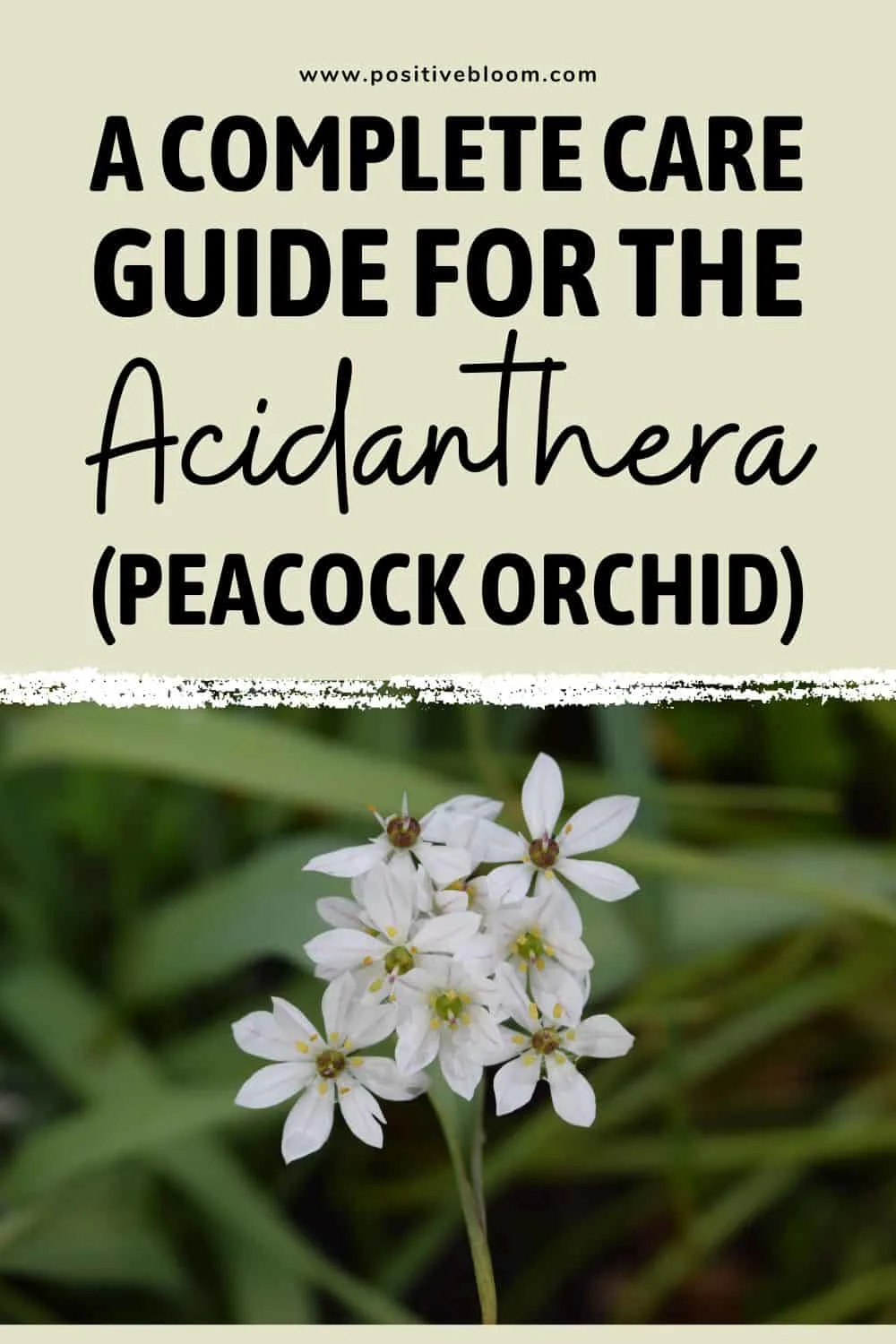

Acidanthera plants are not frost-tolerant, and their bulbs can be damaged by freezing temperatures. In regions with cold winters, dig up the bulbs in late fall and store them in a cool, dry place until spring. Alternatively, grow acidanthera plants in containers and bring them indoors during winter.
By following these maintenance and pruning practices, you can ensure the health and longevity of your acidanthera plants, resulting in beautiful blooms year after year.
Acidanthera: Common Problems and Solutions
Pest Infestation
Pest infestation is a common problem with acidanthera plants. Some pests that can attack acidanthera include aphids, thrips, and spider mites.
Solution:
- Regularly inspect your acidanthera plants for any signs of pests.
- If pests are detected, use an insecticidal soap or neem oil spray to treat the affected plants.
- Ensure proper air circulation around the plants to prevent the buildup of pests.
Disease
Diseases can also affect acidanthera plants, such as fungal infections like gray mold (Botrytis) and root rot.
Solution:
- Make sure that you provide proper drainage for the acidanthera plants to prevent root rot.
- Remove any infected or decaying plant parts to prevent the spread of disease.
- Apply a fungicide to the affected plants according to the manufacturer’s instructions.
Poor Flowering
If your acidanthera plants are not flowering well, it could be due to various reasons such as inadequate sunlight, improper fertilization, or overcrowding.
Solution:
- Ensure that your acidanthera plants receive at least 6-8 hours of direct sunlight per day.
- Apply a balanced fertilizer once a month during the growing season to provide essential nutrients.
- If the plants are overcrowded, divide them and replant them at a proper distance.
Poor Growth
If your acidanthera plants are not growing well, it could be due to factors such as poor soil quality, inadequate watering, or lack of nutrients.
Solution:
- Ensure that you plant acidanthera in well-draining soil rich in organic matter.
- Water the plants regularly, allowing the soil to dry slightly between waterings.
- Apply a slow-release fertilizer during the growing season to provide the necessary nutrients.
- Periodically check the soil pH levels and adjust if necessary.
Winter Protection
During winter, acidanthera plants can be susceptible to frost damage or may not survive in cold climates.
Solution:
- In colder climates, dig up the acidanthera bulbs before the first frost and store them in a cool, dry place for winter.
- Alternatively, you can plant acidanthera in containers and bring them indoors during winter.
- Protect the plants from frost by covering them with a thick layer of mulch or using frost blankets.
| Problem | Solution |
|---|---|
| Pest Infestation | Regular inspection and treatment with insecticidal soap or neem oil spray |
| Disease | Proper drainage, removal of infected plant parts, and use of fungicides |
| Poor Flowering | Proper sunlight, fertilization, and spacing |
| Poor Growth | Well-draining soil, adequate watering, nutrient supplementation, and soil pH adjustment |
| Winter Protection | Storing bulbs or bringing plants indoors, and frost protection |
Questions and Answers:
How do I cultivate and care for Acidanthera?
To cultivate and care for Acidanthera, start by planting the bulbs in a sunny location with well-drained soil. The bulbs should be planted in spring after the last frost. Water the plants regularly, keeping the soil moist but not waterlogged. Fertilize the plants once a month during the growing season with a balanced fertilizer. Remove any faded flowers to prolong blooming. In the fall, after the leaves have turned yellow, the bulbs can be dug up and stored in a cool, dry place for the winter.
What types of Acidanthera are there?
There are several types of Acidanthera, also known as Abyssinian gladiolus or peacock orchid. The most common variety is Acidanthera bicolor, which has white flowers with purple centers. Another variety is Acidanthera murielae, which has white flowers with maroon centers. Acidanthera corms can also be found in various sizes and colors, including pink, yellow, and peach.
When should Acidanthera bulbs be planted?
Acidanthera bulbs should be planted in the spring, after the last frost. This is usually around the time when the soil has warmed up and is workable. Plant the bulbs about 2-3 inches deep and 4-6 inches apart, with the pointed end facing upwards. Make sure to choose a sunny location with well-drained soil for planting.
Do Acidanthera plants require a lot of water?
Acidanthera plants require regular watering to keep the soil moist, but it is important not to overwater them. The soil should be kept evenly moist, but not waterlogged. Water the plants deeply about once a week, or more frequently during dry spells. Be sure to allow the soil to dry out slightly between waterings. Avoid overhead watering, as this can lead to the development of fungal diseases.
How often should Acidanthera plants be fertilized?
Acidanthera plants should be fertilized once a month during the growing season, from spring to fall. Use a balanced fertilizer with an equal ratio of nitrogen, phosphorus, and potassium. This will provide the plants with the necessary nutrients to promote healthy growth and abundant flowering. Be sure to follow the manufacturer’s instructions on the fertilizer packaging for proper application.
Should I deadhead Acidanthera flowers?
Yes, it is recommended to deadhead Acidanthera flowers to prolong blooming. As the flowers fade and start to wilt, simply remove them by cutting off the entire flower stalk at the base. This will prevent the plant from wasting energy on seed production and encourage it to produce more flowers. Deadheading also helps to maintain a tidy appearance in the garden.
Can Acidanthera bulbs be left in the ground over winter?
Acidanthera bulbs are not reliably hardy and are susceptible to winter damage in colder climates. It is best to dig up the bulbs in the fall, after the foliage has turned yellow. Carefully lift the bulbs from the ground and remove any excess soil. Store the bulbs in a cool, dry place for the winter, such as a garage or basement. They can be replanted in the spring, after the last frost, for another season of growth and flowering.







